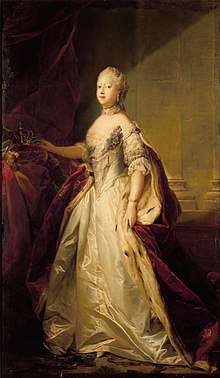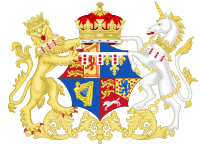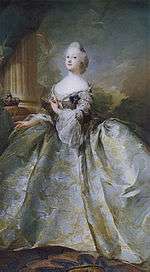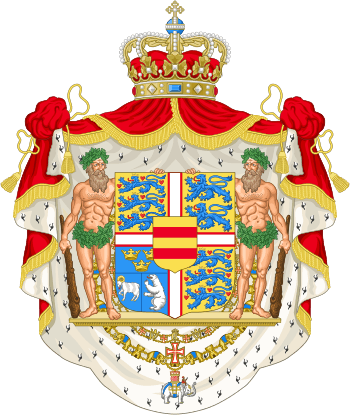Louise of Great Britain
Louise of Great Britain (originally Louisa; 18 December 1724 – 19 December 1751) was Queen of Denmark and Norway from 1746 until her death, as the first wife of King Frederick V. She was the youngest surviving daughter of King George II of Great Britain and Caroline of Ansbach.
| Louise of Great Britain | |
|---|---|
 Portrait by Carl Gustav Pilo, c. 1745 | |
| Queen consort of Denmark and Norway | |
| Tenure | 6 August 1746 – 19 December 1751 |
| Born | 18 December 1724 (New Style) Leicester House, London, England |
| Died | 19 December 1751 (aged 27) Christiansborg Palace, Copenhagen, Denmark |
| Burial | |
| Spouse | |
| Issue |
|
| House | Hanover |
| Father | George II, King of Great Britain |
| Mother | Caroline of Ansbach |
The marriage between Louise and Frederick V of Denmark, was arranged solely for political reasons (King George II’s ministers wanted Danish support in disputes with Prussia)[1], but the couple co-existed well, and Louisa, who encouraged performances by actors and musicians, was a popular figure at the Danish court even though she never exerted significant influence over her husband’s decision-making.[2][1]
Early years
Princess Louise was born as the fifth daughter and youngest child of the then Prince and Princess of Wales, on 7 December 1724, at Leicester House, London.[3] She was baptised "Louisa" there on 22 December.[4] Her godparents were her elder sister and two cousins: Princess Amelia of Great Britain, Princess Louisa Ulrika of Prussia (for whom Sarah Lennox, Duchess of Richmond and Lennox, stood proxy), and Frederick, Prince Royal of Prussia, later Frederick the Great (for whom Henry de Nassau d'Auverquerque, 1st Earl of Grantham, stood proxy).[4]

On 11 June 1727, when Louise was two years old, her grandfather, George I, died, and her father ascended the throne as George II. On 30 August, as a child of the sovereign, Louise was granted use of the arms of the realm, differenced by a label argent of three points, each bearing torteaux gules.[5]
Crown princess
In a dynastic marriage, Louise wed Prince Frederick of Denmark and Norway on 11 December 1743 in Copenhagen. A first ceremony was conducted on 10 November 1743 in Hanover with her brother, the Duke of Cumberland, as the representative of the groom. The Lord Chamberlain ordered the provision of supplies for the Princess, including "sets of royal bedding, portmanteaus, a travelling tea equipage, and items for Mrs. Dives and the “Fubbs” yacht: all to an estimate of £503". [6]
After this, the entourages of Louise and Frederick met at Altona, Holstein, where Louise exchanged her English retinue for a Danish one, headed by her new chamberlain Carl Juel and her head lady-in-waiting Christiane Henriette Louise Juel. Louise and Frederick then travelled together to Copenhagen, where they held their official entry into the capital, followed by a second ceremony with the groom present.[2]
The marriage was proposed by Great Britain. At the time of the marriage, both France and Great Britain wished to make an alliance with Denmark, and Great Britain had the advantage of being able to make a marriage alliance.[2] Frederick's father, King Christian VI, hoped the marriage would lead to British support for his or his son's claim to the throne of Sweden.[7] On a more personal level, there were hopes that marriage would suppress the frequent drinking and debauched behavior of the Crown Prince.[8]
The couple had five children, one of whom did not survive infancy. Although the marriage was arranged, the couple got along quite well, and at least during the first years, their relationship was described as happy.[8] Although Frederick came to feel high regard for her and always treated her with kindness, he reportedly was not in love with her and continued to have affairs after their marriage.[2] However Frederick was comfortable with her, and Louise pretended not to notice his adultery with multiple partners, notably with Else Hansen. She quickly made herself popular in the Danish court, and her father-in-law remarked that she seemed to him to be kind and agreeable.[2]
Queenship
When her husband ascended the throne, on 6 August 1746, as Frederick V, Louise became Queen of Denmark and Queen of Norway.
Queen Louise was very popular in Denmark,[7] and the great popularity of the royal couple has been attributed to Louise.[8] Interested in music, dance and theatre, the royal court acquired a more easy-going tone than under her strictly religious parents-in-law. Louise had a vivacious personality, allowing her to socialise easily with others.[7] In 1747, she arranged for the Italian opera company of Pietro Mingotti, whose members included Christoph Willibald Gluck and Giuseppe Sarti, to play at the royal court theatre, and in 1748, the French Du Londel Troupe was invited for dramatic performances.
Her effort to speak the Danish language, including with her children, was much appreciated, as the royal Danish court spoke mostly German.[9] She studied the Danish language under the court priest Erik Pontoppidan, and also hired teachers so that her children could learn to speak their country's language.[8] She was described as well educated and good at conversation, not beautiful but very dignified and well suited to her role as queen. A Swedish diplomat stationed in Denmark described her as follows:
- "She has good sense and is easy with words, friendly in tone, knows how to converse on many subjects and can speak several languages; while giving court, she seldom leaves anyone without saying something nice; she very much enjoys dance and dances well, she has a good temper and is known for her piety and excellent qualities. She finds pleasure in reading and music, she plays the clavichord well and teaches her daughters to sing."[2]
Queen Louise unsuccessfully opposed the dynastic marriage between her daughter Sophia Magdalena and Crown Prince of Sweden in 1751.[8] The reason was her fear that her daughter would not be well treated by the Queen of Sweden, Louisa Ulrika of Prussia. Louisa Ulrika was known for her anti-Danish views and for being opposed to the match, and it was known that she was the real ruler at the Swedish court.[10] Reportedly, Louise also disliked arranged marriages because of her own marriage.
Early death

While pregnant with her sixth child, Louise died due to complications from a miscarriage on 19 December 1751, a day after her 27th birthday, at Christiansborg Palace, Copenhagen, predeceasing her husband by fourteen years. She was buried at Roskilde Cathedral.
Issue
| Name | Birth | Death | Notes |
|---|---|---|---|
| Christian, Crown Prince of Denmark | Copenhagen, 7 July 1745 | Frederiksborg, 3 June 1747 | died in infancy |
| Princess Sophia Magdalena of Denmark | 3 July 1746 | 21 August 1813 | married, 1766, Gustav III of Sweden; had issue |
| Princess Wilhelmina Caroline of Denmark | 10 July 1747 | 19 January 1820 | married, 1763, William I, Elector of Hesse; had issue |
| Christian VII of Denmark | 29 January 1749 | 13 March 1808 | married, 1766, Princess Caroline Matilda of Wales; had issue |
| Princess Louise of Denmark | 30 January 1750 | 12 January 1831 | married, 1766, Prince Charles of Hesse-Kassel; had issue |
Ancestry
| Ancestors of Louise of Great Britain | |||||||||||||||||||||||||||||||||||||||||||||||||||||||||||||||||||||||||||||||||||||||||||||||||||||||||||||||||||||||||||||||||||||||||||||||||||||||||||||||||||||||||||||||||||||||||||||||||||||||||||||||||||||||||||||||||||||||||||||||||||||||||||||||||||||||||||||||||||||||||
|---|---|---|---|---|---|---|---|---|---|---|---|---|---|---|---|---|---|---|---|---|---|---|---|---|---|---|---|---|---|---|---|---|---|---|---|---|---|---|---|---|---|---|---|---|---|---|---|---|---|---|---|---|---|---|---|---|---|---|---|---|---|---|---|---|---|---|---|---|---|---|---|---|---|---|---|---|---|---|---|---|---|---|---|---|---|---|---|---|---|---|---|---|---|---|---|---|---|---|---|---|---|---|---|---|---|---|---|---|---|---|---|---|---|---|---|---|---|---|---|---|---|---|---|---|---|---|---|---|---|---|---|---|---|---|---|---|---|---|---|---|---|---|---|---|---|---|---|---|---|---|---|---|---|---|---|---|---|---|---|---|---|---|---|---|---|---|---|---|---|---|---|---|---|---|---|---|---|---|---|---|---|---|---|---|---|---|---|---|---|---|---|---|---|---|---|---|---|---|---|---|---|---|---|---|---|---|---|---|---|---|---|---|---|---|---|---|---|---|---|---|---|---|---|---|---|---|---|---|---|---|---|---|---|---|---|---|---|---|---|---|---|---|---|---|---|---|---|---|---|---|---|---|---|---|---|---|---|---|---|---|---|---|---|---|---|---|---|---|---|---|---|---|---|---|---|---|---|---|---|---|---|
| |||||||||||||||||||||||||||||||||||||||||||||||||||||||||||||||||||||||||||||||||||||||||||||||||||||||||||||||||||||||||||||||||||||||||||||||||||||||||||||||||||||||||||||||||||||||||||||||||||||||||||||||||||||||||||||||||||||||||||||||||||||||||||||||||||||||||||||||||||||||||
References
- Panton, Kenneth J. (Panton, Kenneth John), 1945- (2011). Historical dictionary of the British monarchy. Scarecrow Press. p. 304. ISBN 978-0-8108-5779-7. OCLC 897043675.CS1 maint: multiple names: authors list (link)
- Louise, page 399, (Dansk biografisk Lexikon / X. Bind. Laale - Løvenørn) (1887-1905) Author: Carl Frederik Bricka
- Oxford Dictionary of National Biography (Online ed.). Oxford: British Academy, Oxford University Press. ISBN 9780198614128. OCLC 56568095.
- The London Gazette refers to her as "Princess Louisa"
- Marks of Cadency in the British Royal Family
- "Treasury Books and Papers: October 1744 Pages 522-530 Calendar of Treasury Books and Papers, Volume 5, 1742-1745. Originally published by His Majesty's Stationery Office, London, 1903". British History Online.
- Bregnsbo, p. 347.
- Louise, Dansk Kvindebiografisk Leksikon
- Bregnsbo, p. 349.
- Gerd Ribbing (1958). Gustav III:s hustru. Sofia Magdalena. [The wife of Gustav III. Sofia Magdalena] Stockholm: Alb. Bonniers Boktryckeri.
- Bibliography
- Bregnsbo, Michael (2004). "Danish Absolutism and Queenship: Louisa, Caroline Matilda, and Juliana Maria". In Campbell Orr, Clarissa (ed.). Queenship in Europe 1660-1815: The Role of the Consort. Cambridge University Press. pp. 344–367. ISBN 0-521-81422-7.
- Henry Churchyard "Royal Genealogies, Part 10"
- Sam Sloan "Big Combined Family Trees (pafg752)"
- (in Danish) Louise, Dansk Kvindebiografisk Leksikon
- (in Danish) Louise, page 399, (Dansk biografisk Lexikon / X. Bind. Laale - Løvenørn) (1887-1905) Author: Carl Frederik Bricka
External links
| Wikimedia Commons has media related to Louise of Great Britain. |
- Queen Louise at the website of the Royal Danish Collection at Rosenborg Castle
Louise of Great Britain Cadet branch of the House of Welf Born: 18 December 1724 Died: 19 December 1751 | ||
| Royal titles | ||
|---|---|---|
| Preceded by Sophia Magdalene of Brandenburg-Kulmbach |
Queen consort of Denmark and Norway 1746–1751 |
Vacant Title next held by Juliana Maria of Brunswick-Wolfenbüttel |
